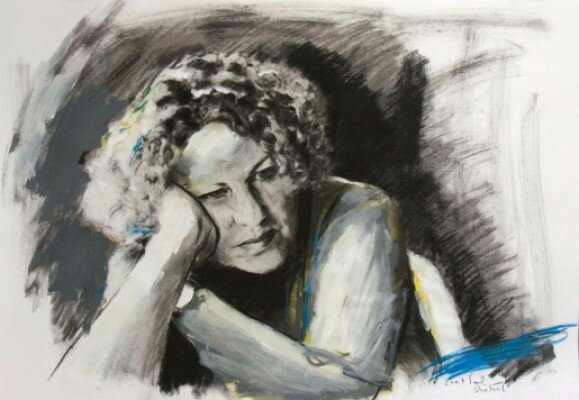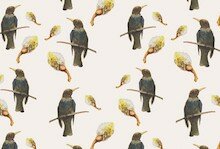The poet as comic sybil

In Israeli poetry’s noise-filled space, Agi Mishol’s lyric voice is one of the most lucid, pleasant and ample. In the more than 10 years since the appearance of her collection Fax Pigeon, recognition of the value and originality of her poetry has become widespread, so that the appearance of each new collection makes critical waves and arouses enthusiasm.
Readers who were familiar with her earlier work, but who perhaps had not devoted enough attention to it, were presented with a poet of extraordinary stature upon the publication of Plantation notes (Keter, 1986). Even current-day readers, pampered by her later collections, have not yet digested everything voiced in this splendid book. It contains much of the emotional fluency characteristic of her earlier poetry and the openness and cognitive flow that mark her style. Nonetheless, this liquidity and openness are poured into substantial molds, whose influence is prominent in individual poems, as well as in the book as a whole, which forms a complex but continuous statement. The overall structure is indeed surprising; the poet’s previous poem cycles simply did not prepare us for this. There is continuity that nonetheless offers variety, a continuum that provides sharp turns, ambiguity that does not exist at the expense of directness (sometimes rather pointed) and clarity of poetic expression. Plantation Notes is a breakthrough book by a young poet who has reached her full strength, the maximum capacity and power of her lyric voice.
Fax pigeon (Hakibbutz Hameuchad, 1991) seems to present the reader with a much narrower area of meaning and tone. This is the impression it was meant to give; the poet declares her intention to contract, to limit herself. In this work, make no mistake, Mishol builds a small, dense and disagreeable world. Almost everything in Fax pigeon is the opposite of what is found in Plantation notes. Whereas in the earlier collection we found ourselves in the toiling village, between the winter pruning and the hot summer harvest, between outbursts of youthful energy and exhaustion at the end of the season, in Fax pigeon we are located inside the farmhouse, none of whose inhabitants is occupied with simple farm labor anymore. And in this house in which the speaker lives, it is not at all simple to sweeten one’s sorrow with a waltz, even if the waltz is as tasty as a Viennese strudel. The dance awakens not only the speaker and her suffering but also the crystal placed atop lace doilies and behind glass: they vibrate ‘out of the desire to knock about’ and to crack. The dragons in the Gobelin tapestry become more threatening in the darkness, and on the sideboard, ‘horny spirits of drunkenness’ ferment in red wine. This collection was the first of Mishol’sbooks to receive serious critical consideration.
If Plantation notes is Mishol’s classical symphony, The interior plain is a romantic one – complex, with less clearly defined divisions,moving back and forth between opposing moods: an opening piece of deep gloom, a long meditative adagio, sehr langsam; joking, energetic scherzos (the supermarket poems, deconstructions of classic texts); and the closing section,which mixes light and shadow, and fear with happiness in a tempo that increases as it moves toward a brilliant prestissimo. In contrast to all this, Look there (Tag, 1999) is a kind of inner chamber music, restrained,free of dissonance as well as of the intense blows of harsh chords.
Mishol belongs to a mode of Hebrew poetry that is not limited to any one particular period, and which does not constitute an uninterrupted historical sequence. Its major representatives in the generation preceding Mishol are Shaul Tchernikovsky, Chaim Lenski and {poet id="3174" title="Nathan Alterman", poets among whom there are few similarities except for the shared aspiration for humor. These so very different poets believed that a humorous glance at the world, and particularly at the self, is a necessary condition for personal mental health,as well as public health and the health of culture, and necessary, too, for the correct balance between critical solidarity and critical distance, in order to achieve equilibrium between the self and the world. It seems that AgiMishol shares this belief completely; it has guided her on a difficult path from the primitive state of the soul, shut within itself, of her early poetry,to her mature work, linked to the reality principle, without losing any of its fascination for the wondrous or the ‘other light’.
Mishol’s poetry acts not only in the literary-poetic field of an Israeli culture struggling to consolidate itself; it also makes a broader attempt to shape a way of life and a world view. For her part Mishol contributes to this effort the splendid example of the possibility of moving from imbalance to equilibrium; from diving down in the depths of the self to knowledge of the world and consideration for the Other; from an enthusiastic affinity for the pleasure principle to the ability to combine it with a more courageous connection to reality, without losing grasp of joy. It is difficult to exaggerate the importance of this balanced cultural model in the midst of a cultural reality which has no mental and intellectual equilibrium whatsoever.
Mishol has written approximately thirty new poems since the appearance of Look there (1999) [including ‘Woman martyr’, which may be found on PIW]. Her work marks a long course of wandering between successful and failed attempts to realize the pleasure principle, and successful and failed attempts to pass the test of reality. As well, we have found in her poetry long, intermittent periods of wishful thinking and daydreaming. Still, the force of the reality principle found expression in Mishol’s work no later than Plantation notes (and in fact, even earlier). Her hold on it has never been as strong as it is now. As we have seen, the poet exhibits a strong, inherent tendency to break through the boundaries of the real toward a desired spirituality. The opposing tendency in her new work, to face reality directly, no matter how painful it is, is, therefore, surprising and wondrous. In her latest poems, Mishol arrives farthest ever in her journey from the poems of her youth, marked by wishful thoughts and daydreams and responding, not with an integrated organization of the soul around the reality principle, but rather by splitting the personality into pieces, some more and some less protected from reality’s claims. In contrast to her earlier work, the new poems reveal the tremendous difficulty raised by adherence to the reality principle, and the complicated coping mechanism it requires of the poet.
We tend to think that contemporary Israeli poetry, which many view as postmodern, is missing a dominant element, an influential and formative poetic center, even just to serve as provocation. If such an approach is true at this poetic-historic moment, it still doesn’t mean that Israeli poetry lacks areas of surplus vitality in contrast with those of reduced energy. In contemporary Israeli poetry, intense, white flames appear against the dark, burning background, whose smoke is greater than the fire. Anyone with eyes in his or her head can see: Mishol’s poetry is one of the brightest of these flames.








